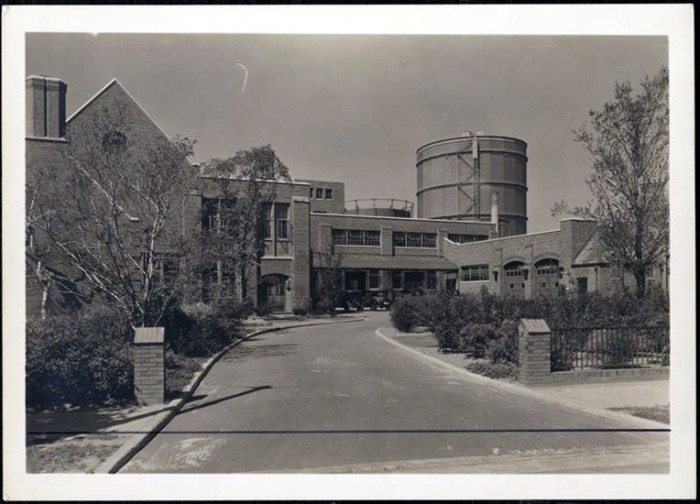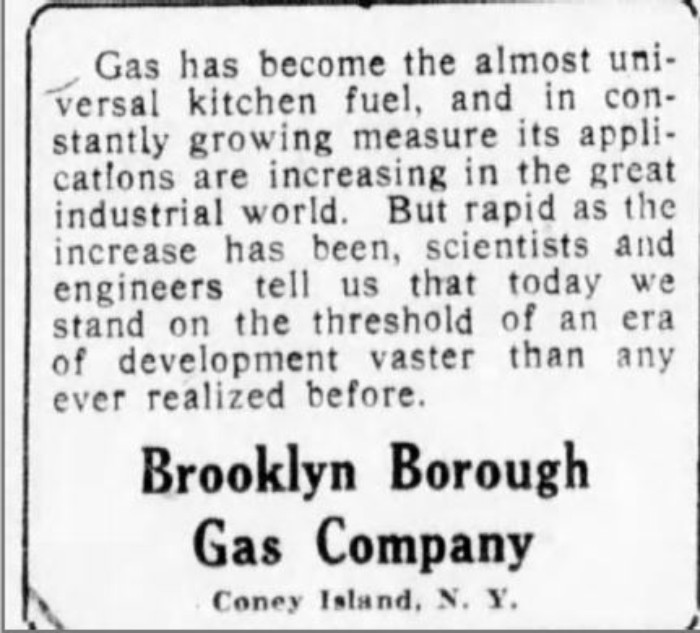Walkabout: Miss Dillon’s Gas Company, Part Two
Read Part 1, Part 3 and Part 4 of this story. The Brooklyn Borough Gas Company out on Coney Island was the little utility that could. After the Civil War, local gas companies sprang up all across Brooklyn to service a growing population with gas for lighting, heat and other uses. As time passed, the…


Read Part 1, Part 3 and Part 4 of this story.
The Brooklyn Borough Gas Company out on Coney Island was the little utility that could. After the Civil War, local gas companies sprang up all across Brooklyn to service a growing population with gas for lighting, heat and other uses. As time passed, the stronger companies absorbed the weaker ones. By the end of the century, most of the remaining gas companies decided to join together to form Brooklyn Union Gas. But not Brooklyn Borough Gas. They were not owned locally, their majority stockholders were a group of men from Philadelphia, and were able to resist Brooklyn Union Gas’ influence.
The company carved out its niche on Coney Island, servicing the communities of Gravesend, Coney Island and Sheepshead Bay. They were content with that, and settled down to strengthen what they had. By 1903, they had a young lady working in the office as a junior clerk. She was the only woman working in any capacity at Brooklyn Borough Gas at that time. Her name was Mary E. Dillon, and she was 17 years old. She had taken her sister’s place in the company when her older sister quit to get married, and Mary didn’t know anything about gas. Her sister had been BBG’s first female employee. For more background, please read Chapter One of this story.
Mary Dillon had determination and she was smart. She spent the next few years taking on any task in the company they offered her, and through that, became both office manager and an expert in all areas of the ever evolving gas business. By 1912, she was assistant to the general manager. She remained in that position until he decided to leave the company in 1919. By then, it was obvious that 33 year old Mary Dillon was the right person to succeed him as general manager.
During the late ‘teens, Brooklyn Borough Gas was trying to expand within its territory. Electricity had made gas light obsolete, but had opened up new technologies for gas production and use. Of course, like any utility, in order for them to change and grow to serve more customers, they wanted a rate increase, and that was not going down well with customers or local officials.
The company’s stock had been rising steadily since the beginning of the 20th century, but problems with rate increases were taking a toll on profits. The same year that Mary was up for the position of manager, the company was almost bankrupt, and rumors swirled around that they would have to sell or go under. For many companies, this would not be a time to hire the first woman general manager of a utility in the country, so the board quietly gave her the job, but not the title.
After a series of public and private meetings with city and community authorities, Mary and the board were finally able to get a rate increase commensurate with what Brooklyn Union Gas customers were paying. This allowed them to offer a better quality gas to customers, and improve their piping and other infrastructure. The stock began to rise again, and confidence in the company was restored. Mary Dillon had weathered her first big storm. There was little doubt that she was able to run the company, and finally, in 1924, the Board of Directors announced that she was the new Vice President and General Manager of Brooklyn Borough Gas.
That year, the company began running a series of announcements in the Brooklyn Eagle. Not ads, but simple statements of company purpose and goals, they were reminders of what the gas company meant to Coney Island. Mary Dillon knew that while the gas industry might be thought to be a messy man’s world, it was, in fact, used primarily by the women of Coney Island. Gas stoves and other appliances were taking over the market, and these were women’s tools. These ads, placed in the women’s pages of the paper, were gentle reminders that gas was important and worth paying for.
Throughout 1925 and into 1926, the price of BBG stock soared, rising from $50 to $75 in the course of only a month at one point. The owner of the company, Mr. Foederer of Philadelphia, died in late 1925, and his heirs were looking to sell. Brooklyn Union Gas, which had long wanted the buy the company, started selling off its electric company holdings at the same time. Many analysts thought they were getting up capital for the big buy. When asked about it, officials of BUG demurred. Mary Dillon was also mum, stating that she had no knowledge of BUG’s intentions.
The stock continued to rise, and late in 1925, the company was sold. But not to Brooklyn Union Gas. The buyer was Frank T. Hulswit, representing the United Light and Power Company. He paid $107.50 a share for controlling interest in the company. Hulswit was already a gas man; he had been on the board of United Light and Power for many years. They were a huge gas and electric company which served parts of Pennsylvania and the Mid-Atlantic states, on into the Midwest and eventually, as far west as the Dakotas. Hulswit took over as President of Brooklyn Borough Gas, with Mary Dillon as VP.
But not even a year later, Hulswit had to resign. He had overextended himself and the company with some bad stock trades and poor financial decisions. The rest of the United Light and Power board had to absorb and make up his losses, and he was out. They unanimously voted Mary E. Dillon into the position of President of the Brooklyn Borough Gas Company in March of 1926.
The news of a woman running BBG made the papers, and everyone wanted to interview the first woman to run a utility in the United States, no, the world. But not everyone was happy about it. One writer in the Brooklyn Eagle, columnist John MacElhinney, wrote “We note that the Brooklyn Borough Gas Company, a $5,000,000 company, now has a woman president. She must be a wonderful woman and it would be a privilege to meter.” (He must have waited days to use that pun.)
“She will probably state that the happiness of her success in the business world is as nothing compared to the happiness she had when working over her own stove in her own home. She will also, since she is a good business woman, advise other women to stick to housekeeping and to do a lot of cooking. This gas company’s secretary and treasurer are also women. However it is reported that the janitor and the porters are men.”
“Strange things are certainly happening these days. It seems as though fatherhood were the only position left sacred to men. What with women Senators, women Congressmen and women businessmen, there won’t be anything left for the men to do but go fishing.” Was he being witty and tongue-in-cheek? Who knows?
The Brooklyn Eagle did send a female reporter out to Coney Island to interview Miss Dillon. Marjorie Dorman, the reporter, probably spent her days reporting society weddings, luncheons and other “women’s stories.” He piece, situated in the women’s section of the paper, began, “And now it’s the bobbed haired president of a public utility who holds the center of the Brooklyn stage and blazes a national trail. She is pretty Mary Estelle Dillon who yesterday was elected President of the Brooklyn Borough Gas Company.”
Dorman went on to say, “Brooklyn business women, discussing the startling fact yesterday reverted to the eternal feminine and expressed envy of – what do you think? Not Mary’s salary, running into five figures, but Mary’s hair-cut. ‘It’s just boyish enough – it’s exactly the semi-boyish cut I’m trying to get,’ said one girl, and another, ‘Did you see how lovely she looked in that red velvet evening gown – she’s so young looking!”
The article went on to note that Miss Dillon was actually in real life, Mrs. Henry Ferber, and she had a pack of unmarried sisters behind her. But much of the article talked about what Mary Dillon looked like; her petite frame, pretty blonde hair, blue eyes and girlish figure. Her fashionable, but practical business clothing was also discussed. But finally the article got down to business, and the reporter asked Miss Dillon about her rise to success. Mary Dillon was very candid. She spoke about her start in the company as “the office boy.”
“I wanted to know everything about the business there was to know. Women themselves are to blame for their lack of interest in the engineering problems of business. Women, for the most part, lack courage. Men take it for granted that women can’t understand the technical phases of business, and the women have a tendency meekly to acquiesce instead of asserting and insisting upon their right to be in every phase of business. I want my girls to feel they are capable of doing anything men can do. It is the only way for a business to progress.”
Brooklyn Borough Gas was in good hands. They were very profitable, their stock was strong, and they had the backing of a huge company behind them. It was time to start moving forward with Mary’s plans for growing the company. The power of the company was in the hands of a woman, and Mary Dillon knew that marketing to women would be the key to growth. For most women in the 1920s, that revolved around the kitchen.
The kitchen had gone from the exclusive domain of servants to the heart of the modern home. Whether one lived in a house or an apartment, every woman in Coney Island wanted a new and modern kitchen, with countertops, cabinets and the newest gas appliances. Appliance companies were opening everywhere, as stand-alone stores, or in conjunction with major department stores. What better place to show what an appliance can do than at the gas company?
Mary Dillon and her team set about to build the most modern, convenient, and elegant utility company headquarters in Brooklyn. It would be corporate headquarters, a bill payment office, and a showroom and domestic laboratory where women could learn new cooking skills and use the latest gas powered equipment. The new building would be beautiful, and would appeal to a woman’s sense of home. It would also be a practical gas plant where millions of gallons of manufactured and natural gas was processed and stored. This would be some facility. And so it was.
Next – the new Brooklyn Borough Gas Company Headquarters on Neptune Avenue in Coney Island, and the continuation of the story of Miss Mary E. Dillon.
(Brookyn Borough Gas Company’s new headquarters on Neptune Avenue in Coney Island. Photo taken in 1933. From the collections of the Museum of the City of New York.)








What's Your Take? Leave a Comment